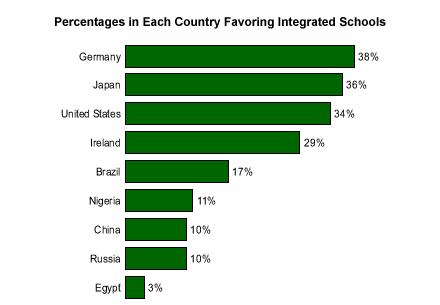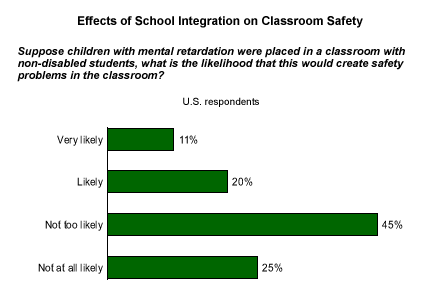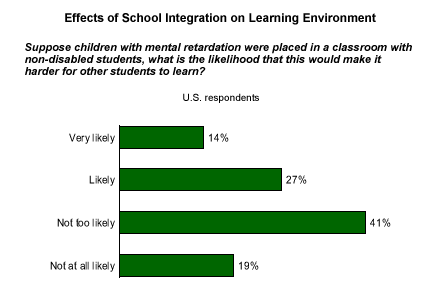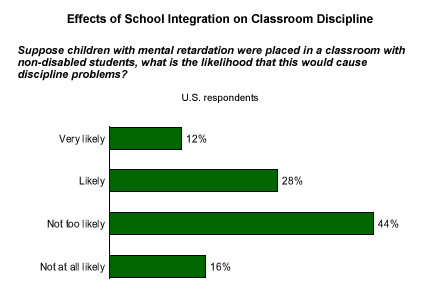First in a two-part series
The question of whether and which students are best taught separately has almost as many facets as there are different kinds of children. Do boys and girls learn better in separate classrooms? How about slow learners and overachievers, gay and straight students? There is a delicate balance between efficiency and inclusiveness. Should classrooms be formed according to student capabilities to maximize learning time, or should inclusiveness be put first, with class structures designed around the idea that all students should have identical educational opportunities?
In the United States, the debate was largely resolved in 1975 with the passage of the Individuals With Disabilities Education Act (IDEA), which had the explicit goal of providing children with special education needs access to the same public school education that other American children enjoyed. The law, which is currently going through the reauthorization process on Capitol Hill, includes strong language in favor of inclusive education.
Nevertheless, a new multinational study administered by Gallup and the University of Massachusetts Boston for Special Olympics* finds that only about one in three Americans (34%) think kids with mental retardation should attend the same schools as other kids -- almost all the rest say special schools would be a better option for them.
Global Context
The study, which gauges attitudes and perceptions in various countries toward people with intellectual disabilities (or mental retardation, as it is more frequently called in the United States), provides an interesting perspective on inclusiveness in education. Even if curricular differences are minimized, as IDEA mandates, does physical separation in special schools make it harder for kids with intellectual disabilities to integrate into other areas of society as adults? Advocates for such children, including those at Special Olympics for whom the study was conducted, feel it absolutely does.
The fact that only one-third of Americans do not feel separate schools are the best option for such children poses a considerable challenge to that perspective -- but that percentage is relatively high compared with the other countries included in the study.


The countries most supportive of integrated schools tend to be more democratic societies than those that are less supportive of the concept. Equality of opportunity for all children, including those with mental retardation, seems to be a higher social priority in Germany, for example, than in China or Egypt. Furthermore, countries in which people have lower expectations for the capabilities of people with mental retardation tend to be lower on the list. In the two lowest countries, Nigeria and Egypt, respondents are far less likely than those in the United States to believe people with intellectual disabilities are capable of sustaining friendships, or even of washing and dressing themselves. Naturally such perceptions, accurate or not, would lead to a greater perceived need for separation.
Classroom Complications?
In the United States, concern about the needs of non-disabled students -- as well as those of the students with disabilities -- may complicate opinions about the appropriateness of teaching the two together. The survey asked respondents about a variety of potential problems that could occur as a result of integrating students with mental retardation with other students.
While most Americans don't foresee these potential problems, substantial minorities do. About 4 in 10 feel that integration would likely cause discipline problems or make it harder for other students to learn, and 3 in 10 say integration is likely to create safety problems in the classroom.



Bottom Line
Twenty-eight years after IDEA established a legislative mandate for making public education as inclusive as possible for disabled children, there is a substantial amount of skepticism about including children with mental retardation in classrooms composed predominantly of non-disabled kids. Some of this skepticism may be addressed by improved public education about the range of capabilities that children with mental retardation have, and the resources required to effectively integrate them into mainstream educational facilities. The second part of this series will examine Americans' perceptions of the biggest obstacles to such integration, and how those perceptions compare with those in the other countries included in the study.
*For the Multinational Study of Attitudes Toward Individuals with Intellectual Disabilities, more than 6,400 interviews were completed by The 优蜜传媒Organization with adults in Brazil, China, Egypt, Germany, Japan, Nigeria, Russia, and the United States. A minimum of 800 interviews were conducted with a general population of adults in each country. In the United States, interviewing was conducted between Oct. 7 and Nov. 18, 2002. In total, 801 Americans age 18 and over were interviewed in the study. Results based on this sample size are subject to an error attributable to sampling and other random effects of ±3 percentage points at the 95% confidence level.